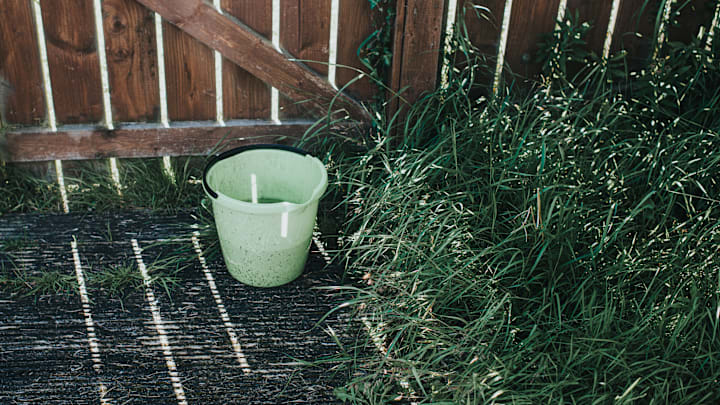If you’ve been on social media recently, chances are you’ve seen the viral “bucket of doom” technique that’s being widely shared as a means of ridding your garden of mosquitoes this summer. But like many online hacks, this technique might not be quite as reliable (or as safe) as it might appear.
What is the “bucket of doom”?
Many species of mosquito lay their eggs in stagnant water, and the “bucket of doom” hack works by providing them with precisely the environment they need to reproduce.

First, a plastic five-gallon tub is filled with water, grass cuttings, leaf litter, weeds, and other garden detritus to replicate the murky pool of water that a female mosquito might find enticing. Then, mesh or chicken wire can be placed over the bucket—or a few holes drilled into its lid—which allows adult mosquitoes inside while preventing birds and other small animals from falling in.
The final touch is adding a pellet of “mosquito dunk,” or mosquito granules, to the water. This dissolvable insecticide contains a natural bacterium called Bacillus thuringiensis israelensis, or Bti. The bacteria in the water kill off larvae before they have a chance to turn into biting adults. Keeping a handful of these buckets around your garden is therefore touted as an easy method of controlling mosquito numbers, and a cheaper (and less ecologically destructive) alternative to pest control sprays or misting the entire garden with clouds of insecticide.
How safe is Bti?
Thankfully, the problems with this hack don’t involve Bti. Bti is found naturally in soil and isn’t harmful to humans, birds, animals, fish, and household pets, or to helpful back yard critters like bees and butterflies [PDF].

The bacterial spores are toxic to mosquitoes and their larvae (as well as other garden pests, like blackfly), though: When they ingest them, the toxins inside the spores work to dissolve the larvae’s gut lining, causing them to perish within a matter of days.
Mosquito dunks are biodegradable too, so according to experts, they’re safe not just for a “bucket of doom” but for any unmoving body of water around the garden—including ponds, rainwater barrels, and even birdbaths.
So what’s the problem with the “bucket of doom” hack?

There are several flaws in the “bucket of doom” hack, according to entomologists and gardeners.
Not all mosquitoes lay their eggs directly in water.
From a bug-reducing point of view, it’s important to note that some mosquitoes don’t lay their eggs in water but instead deposit eggs close to a water source, in wet soil, or in damp tree bark. Even those that do use stagnant water typically won’t lay all their eggs in the same place, but instead lay several different batches of eggs in multiple locations. So the bucket of doom might only prove effective on a relatively small portion of a female mosquito’s potential offspring.
Only larvae are affected by the “bucket of doom.”
Mosquito dunks also only affect mosquito larvae, not the adult insects, so bugs that are already flying around will be free to continue annoying and biting you (and potentially spreading disease). To kill those, look at getting a pest control spray, or be patient and wait for the adults to die off naturally: Depending on conditions, adult mosquitos typically have a lifespan of a few days to a month or so. Lifehacker also suggests setting up a box fan to keep mosquitoes—which are not great fliers—away from you when you’re outside.
The buckets and Bti don’t last forever.
Then there’s the fact that the buckets have their own lifespan. Although a mosquito dunk will usually work for around 30 days, it can lose some of the effectiveness over time, especially if the water is in direct sunlight or temperatures outside climb too high. In certain conditions, in fact, mosquito dunks might only remain functional for a week or so. With no way of telling whether yours is still functional, you might well end up worsening your mosquito problem (or throwing away a perfectly serviceable bucketful of doom!).
Open buckets of water can be dangerous.
Lastly, having open buckets of stagnant water lying around the garden is not only unsightly, but is potentially dangerous to small kids, pets, and wildlife. Animals like squirrels or mice can easily become tangled in the mesh or netting that’s sometimes used to cover the buckets, or they can easily fall in to a bucket that’s kept open. (Leaning a stick into an open bucket to act as an escape ramp is at least one way of keeping small mammals safe.)
And you’ll still need to clean them periodically.
Even if you’re careful, though, you’re still going to have to clean the buckets when mosquito season is over, which will hardly be the most pleasant of garden chores.
In short, buckets of doom have their pros and cons. They’re certainly a cheaper and more natural alternative to many other mosquito-killing options, but whether they’re worth the effort, the unsightliness, and the potential risks is something you’ll have to decide.
Discover More Stories in Live Smarter:
